10 Contemporary Women Artists to Know
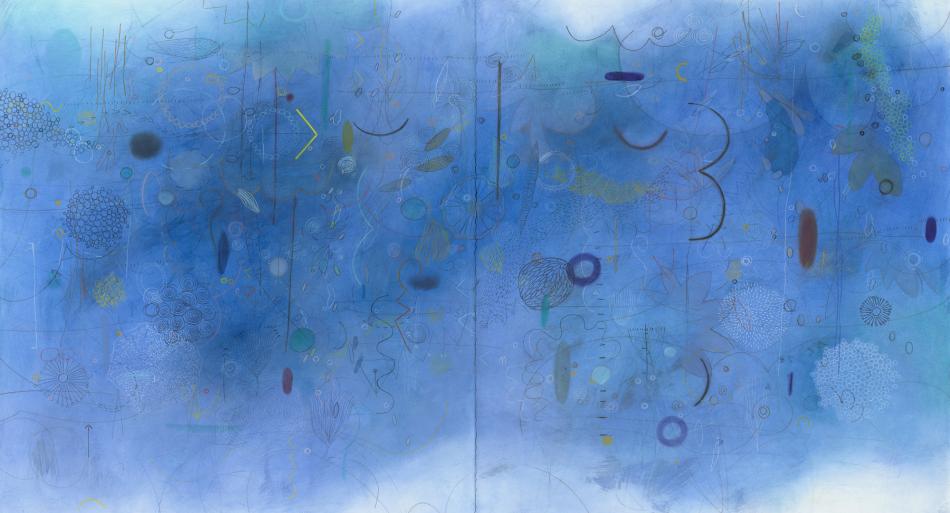
Brush up on works by contemporary painters, sculptors, photographers, and multimedia and conceptual artists. Their styles are as diverse as their sources of inspiration, which range from nature and religion to history and technology.
Many might be new to you—works by these 10 were added to our collection in the past two years.
1. Jaune Quick-to-See Smith
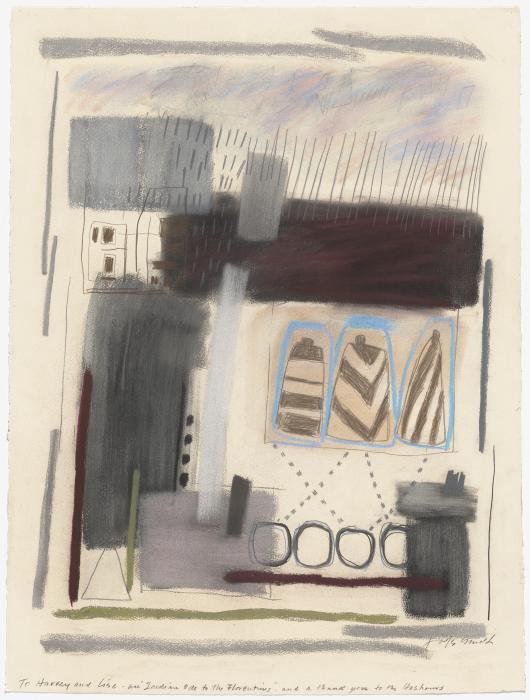
Jaune Quick-to-See Smith (Citizen of the Confederated Salish and Kootenai Nation), An Indian Ode to the Florentines, 1980, pastel, colored pencil, and graphite on wove Arches paper, Gift of Harvey & Lise Hoshour
Jaune Quick-to-See Smith (Citizen of the Confederated Salish and Kootenai Nations) is committed to raising awareness of the breadth of Native American art across the United States. In addition to making paintings, sculptures, and prints, Quick-to-See Smith is an activist, educator, and curator. (She organized our recent exhibition, The Land Carries Our Ancestors: Contemporary Art by Native Americans.)
Quick-to-See Smith made this pastel drawing after a visit to the National Gallery in 1979. At the time, she worked in a semi-abstract style. This drawing represents seeing Italian Renaissance paintings. The artist wrote a note describing the memory: “It is raining in Washington / The three of us circled in blue /are admiring the Florentines.” She gave the drawing to her companions from that trip, Lise and Harvey Hoshour, and they recently donated the work to our collection. We also have two more recent paintings by Quick-to-See Smith in our collection: Target and Adios Map.
2. Belkis Ayón
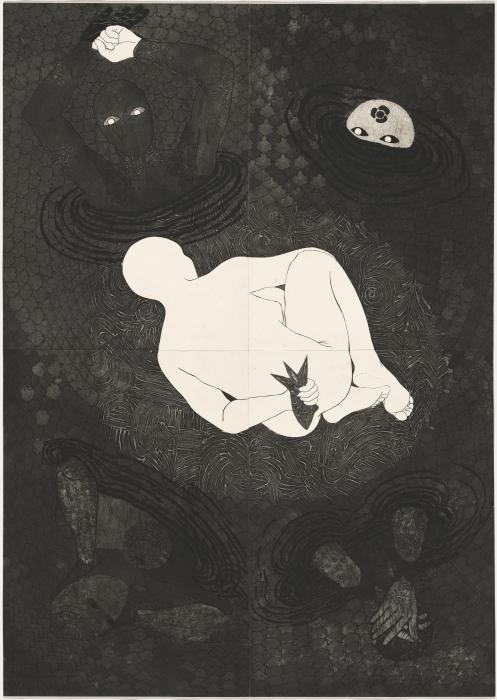
Belkis Ayón, Sin titulo [Mujer en posición fetal] (Untitled, Woman in fetal position), 1996, collograph on four sheets of wove paper, Patrons’ Permanent Fund and Gift of Funds from Philip D. Berlin, Carmen Corrales, Ernesto Poma, Elizabeth Dascal, and Charles Boyd
In her short life, Belkis Ayón made her mark with masterful prints. The Cuban artist explored the mysterious iconography of Abakuá, a secret Afro-Cuban brotherhood that enslaved men from Nigeria brought to the island in the 19th century.
Sin título [Mujer en posición fetal] (Untitled, [Woman in fetal position]) refers to the Abakuá myth of the princess Sikán, the martyred mother of the brotherhood. Sikán accidentally discovers Tanze, a sacred fish that promises power to those who hear its voice. Sikán tells her father, who swears her to silence. Disobeying, she shares the secret with her lover, an enemy prince. Sikán is condemned to death, and Tanze dies with her. The story’s themes include power, control, censorship, violence, and freedom. All of these relate to Ayón’s life as a Black Cuban woman artist at the end of the 20th century.
Ayón considered Sikán an alter ego: an “observer, intermediary, and revealer.” She also saw the princess as a reflection of herself and other women marginalized by male-dominated societies. The artist traced her body to create the silhouetted figure at the center of this print.
3. Hung Liu
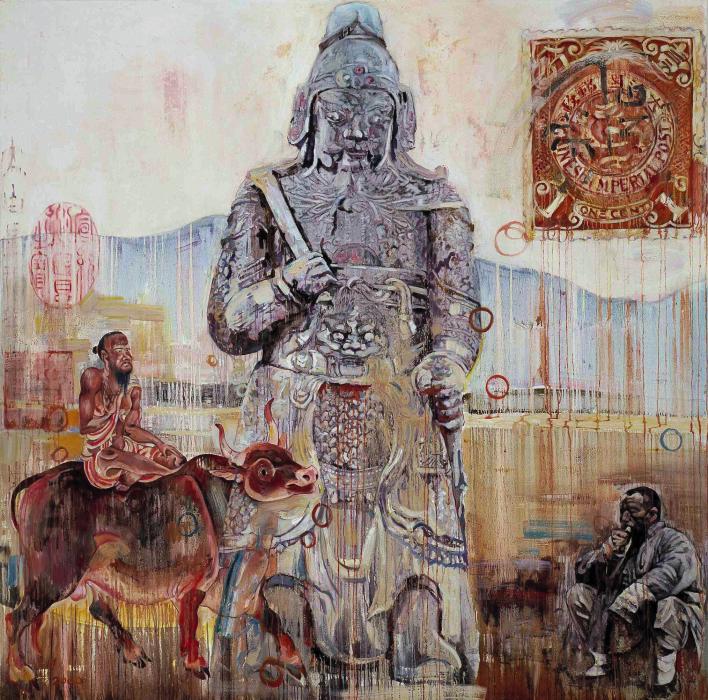
Hung Liu, Post-Age, 2000, oil on canvas, Gift of Marsha Graces Williams, 2023.78.1
The late Hung Liu created paintings that connected the past with the present. Liu’s artistic training in China and her studies of conceptual art both influenced her. Her works focused on overlooked histories and figures.
Liu came of age in China during the Cultural Revolution, a communist movement led by Mao Zedong. Art of the period presented a romanticized version of Chinese history and life. Photographs of the past were forbidden. Liu made her paintings after immigrating to the United States in response to that sanitized and prescribed version of history.
In paintings like Post-age, Liu transformed images sourced from historical photographs. The stone warrior in the center comes from a 19th-century postcard of the Imperial Ming Tombs near Beijing, China. Liu layers on images from other periods. On the left, an ox carries philosopher Lao Zi, and a peasant rests on the right. To Liu, history was “not a static image or a frozen story. It is always flowing forward.”
4. Renée Green
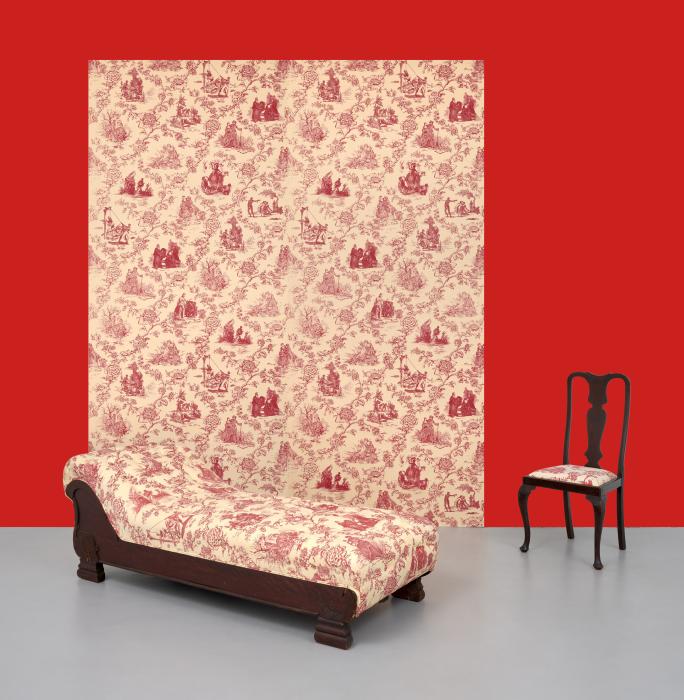
Renée Green, Commemorative Toile, 1992–1993, two lengths of custom-printed fabric (toile), custom upholstered wood chair, custom upholstered divan, Pepita Milmore Memorial Fund and Firestone Contemporary Art Acquisition Fund, 2023.28.1
American artist Renée Green has made installations that include many mediums: painting, photography, film, and sound. Her heavily researched works explore history, memory, and race through a variety of forms.
Green first made Commemorative Toile during a residency at the Philadelphia Fabric Workshop in the early 1990s. The 17th-century decorative French Toile de Jouy fabric has South Asian origins. It typically shows Rococo scenes of country life and romantic trysts. Here, Green replaces them with images of engravings from the seminal book The Image of the Black in Western Art. The images include violent depictions of the trans-Atlantic slave trade and the Haitian Revolution. Toile is also connected to the slave trade. Some of the first examples were exported through Nantes, France, a center of the triangular trade of enslaved peoples.
5. Emmi Whitehorse

Emmi Whitehorse (Diné) creates works that capture the harmony of the landscape of her home near Santa Fe, New Mexico. Paintings on paper mounted to canvas like Fog Bank immerse us in her vision of the natural world. The artist encourages us to take time with her works, as if we’re talking a stroll through them. “As you’re walking, you might see little twigs that had blown onto your path, things moved around by wind . . . water, all the tracks that animals leave behind,” says Whitehorse. The marks and forms that fill this painting symbolize specific plants, people, and experiences.
Whitehorse made the ethereal blue atmosphere by rubbing pigment directly into the paper with her hands. Her grandmother, who worked as a sheepherder, inspired this technique. Whitehorse sees a connection between how her grandmother used her hands working with wool and the way she builds up the raw pigment in her paintings by hand.
6. Liza Lou

Liza Lou, Closet, 1997 - 1998, glass beads, wood, and New York couple's empty bottles and unwanted household objects, Gift of Sherry and Joel Mallin, 2022.187.1
American artist Liza Lou is known for paintings, sculptures, and room-size installations covered in glittering glass beads. Lou’s mesmerizing creations can be deceiving. It can take a few moments to register that every surface has been painstakingly covered in tiny glass beads.
Closet is one of five major beaded installations Lou made in the 1990s. While it may simply look like a replica of a utility closet, it is also a portrait of a marriage. For one year, couple Joel and Sherry Mallin sent discarded household items to Lou, from empty cleaning bottles and paint cans to old tennis shoes and board games. Lou encrusted the objects in brightly colored glass beads and arranged them in a closet. She included the doors and shelves of the original closet—also covered in beads, of course.
Lou’s sculptures glamorize and elevate craft and unseen domestic labor, both often considered “women’s work.”
7. Gillian Wearing
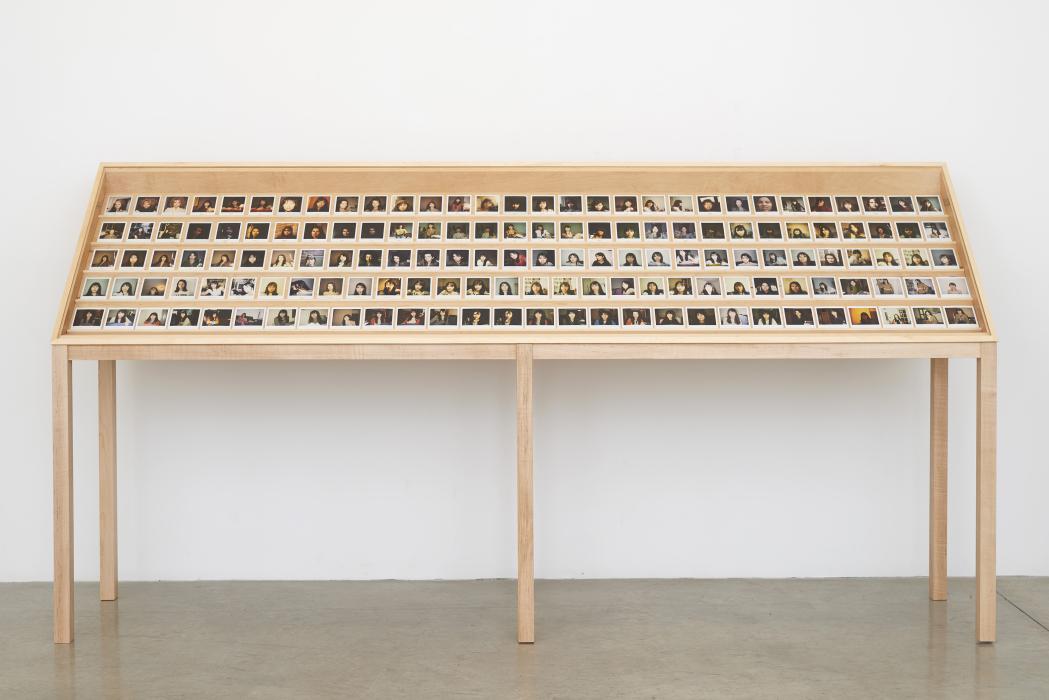
Gillian Wearing, My Polaroid Years, 1988–2005, 148 internal dye diffusion prints (Polaroid SX-70), Gift of the Tony and Trisja Podesta Collection, Washington, DC, 2023.136.2. © Gillian Wearing, Courtesy of the artist, Tanya Bonakdar Gallery, New York / Los Angeles and Maureen Paley, London
English artist Gillian Wearing explores questions of identity through self-portraiture. My Polaroid Years is one of her earliest projects. Between ages 24 and 42, Wearing took 148 Polaroid photographs of herself. The photos aren’t just meant to chart her aging. They also document the evolution of her interest in the portraiture as performance. Typically displayed together, the photographs show Wearing experimenting with different wigs, hairstyles, makeup, lighting, and poses.
Wearing rediscovered the Polaroids only recently. She found that she looked at them differently in today’s age of the selfie:
“There is a similarity in my posing and the poses of a lot of young women you now find on Instagram and Twitter, etc. Whilst thinking we are, or wish to be ‘unique’ we find that the collective resemble one another in poses that are learned and/or copied from an early age.”
8. Marjorie Strider
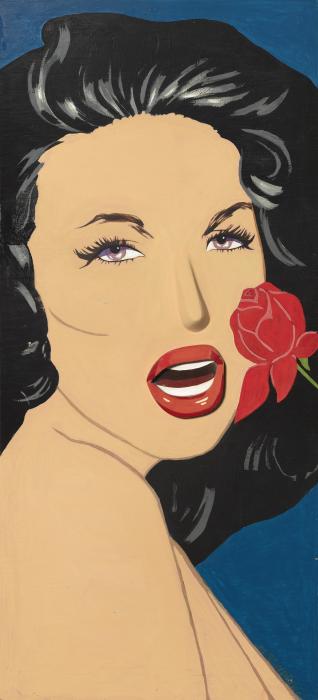
Marjorie Strider, Girl with Rose, 1963, acrylic on plywood, Gift of John Wilmerding, 2022.153.1
When we think of pop art, Andy Warhol or Roy Lichtenstein may come to mind. But women artists like Marisol and Marjorie Strider also reinterpreted popular culture in the 1950s and ’60s. Strider became known for her “build-out” paintings. In these, she added three-dimensional elements to images of the female form. By raising objectified women from a flat surface into the viewer’s space, she challenged the passive and voyeuristic gaze.
Girl with Rose is a pinup-style image of a dark-haired woman with ruby red lips and a red rose. Strider added a doorstop for her nose and plastic for her lips. The image is closely cropped, and the woman’s gaze confronts us directly.
Over her long career, Strider worked in a variety of styles. In the late 1960s and ’70s, she participated in and organized happenings, an early form of performance art.
9. Analia Saban
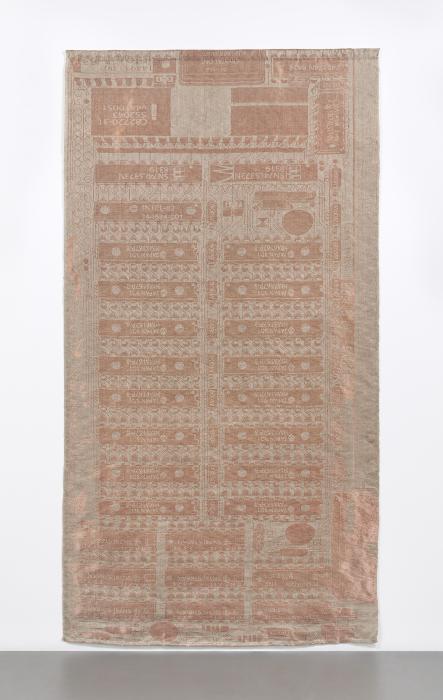
Analia Saban, Copper Tapestry (iSBX 275 Graphics Card, Intel, 1983), 2020, woven copper wire and linen thread, Avalon Fund, 2023.27.1
How do art and technology intersect? Argentine American artist Analia Saban considers this question through a variety of mediums. In works like Copper Tapestry (iSBX 275 Graphics Card, Intel, 1983), she reveals links in the history of the two fields.
In 1803 Joseph Marie-Jacquard invented a mechanized loom that used punch cards with binary code to indicate patterns and threads. Beyond its impact on textile production, that invention had great implications for the technology we use today. The same type of punch card would later be used to input data into what is considered the first computer, the analytical engine, and even into mid-20th-century digital computers.
For her series of tapestries, Saban uses the computer’s origin (a loom) to create an image of its descendant, a computer graphics card. The shimmering textile is woven from copper thread, which also references a computer card’s circuit board. By creating an image of the card (rather than the image that the card produces), Saban may be inviting us to consider the role computers play in how we see the world.
10. Vera Lutter

Photographer Vera Lutter captures the wonders of the present using the magic of the oldest known camera type, camera obscura. A camera obscura is a dark room or box. The only light comes through a small pinhole or lens, which projects an image onto the opposite wall.
In 2013 Lutter traveled to her native Germany to photograph the Effelsberg telescope, one of the largest radio telescopes in the world. Over the course of a month, she began to see the parallels between her method and subject. Both the camera obscura and telescope transform electromagnetic waves—radio waves for the telescope and light waves for the camera—into pictures. Both expand our understanding of time. Telescopes can capture radio waves from hundreds of light years earlier. Camera obscura photographs can condense hours (or even days) into a single image.
Lutter’s photographs reverse the tones of her original subject, which gives them an otherworldly quality. In Radio Telescope, Effelsberg 111, September 2, 2013, the satellite appears to emit energy in the form of a glowing halo. As a rule, Lutter does not alter her photographs. “I sit back and let the world unfold, and whatever happens, happens,” she says.
You may also like
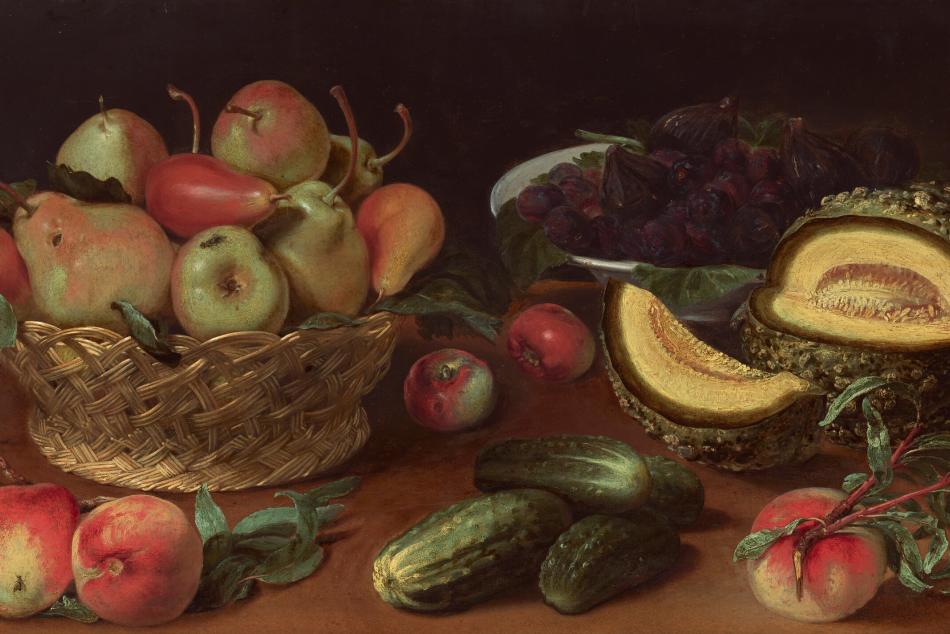
Article: Three Women Artists You May Not Have Heard Of
Meet the 17th-century painters Fede Galizia and Gesina Ter Borch. And see the only known work by Caterina Angela Pierozzi.
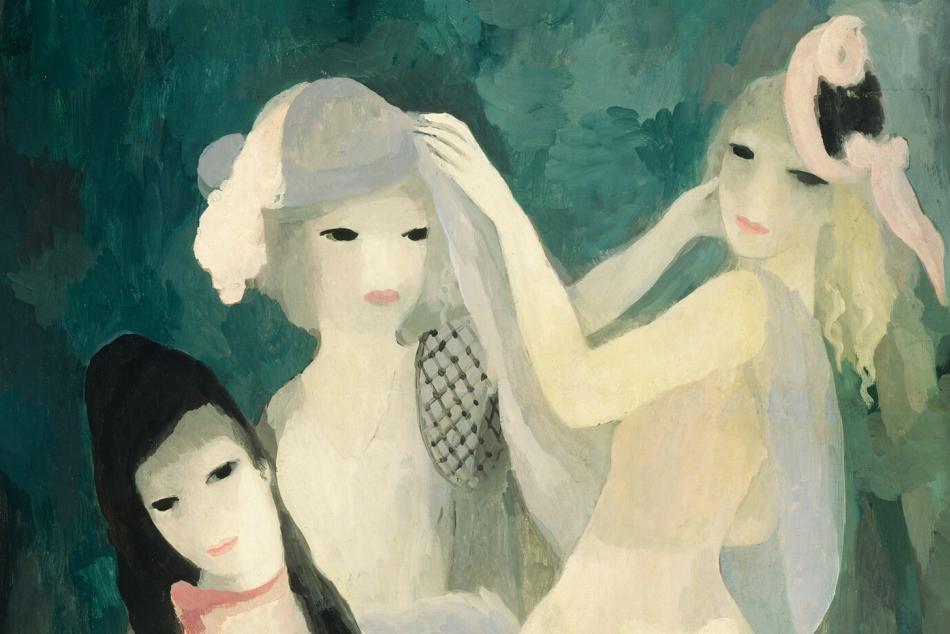
Article: Your Tour of LGBTQ+ Artists at the National Gallery
See these 10 works by queer artists during your next visit.


